Project Management and Risk: Equipment Procurement for Smyth Lodge Care Home
VerifiedAdded on 2023/06/10
|18
|5273
|330
AI Summary
This report discusses the procurement of patient lift equipment for Smyth Lodge care home in the UK. It covers the main drivers of equipment implementation, risk assessment and recommendations for types of contracts, and consideration for the project team structure and management. The report also includes project life cycle stages, project management methodologies, and risk management techniques and mitigation strategies.
Contribute Materials
Your contribution can guide someone’s learning journey. Share your
documents today.
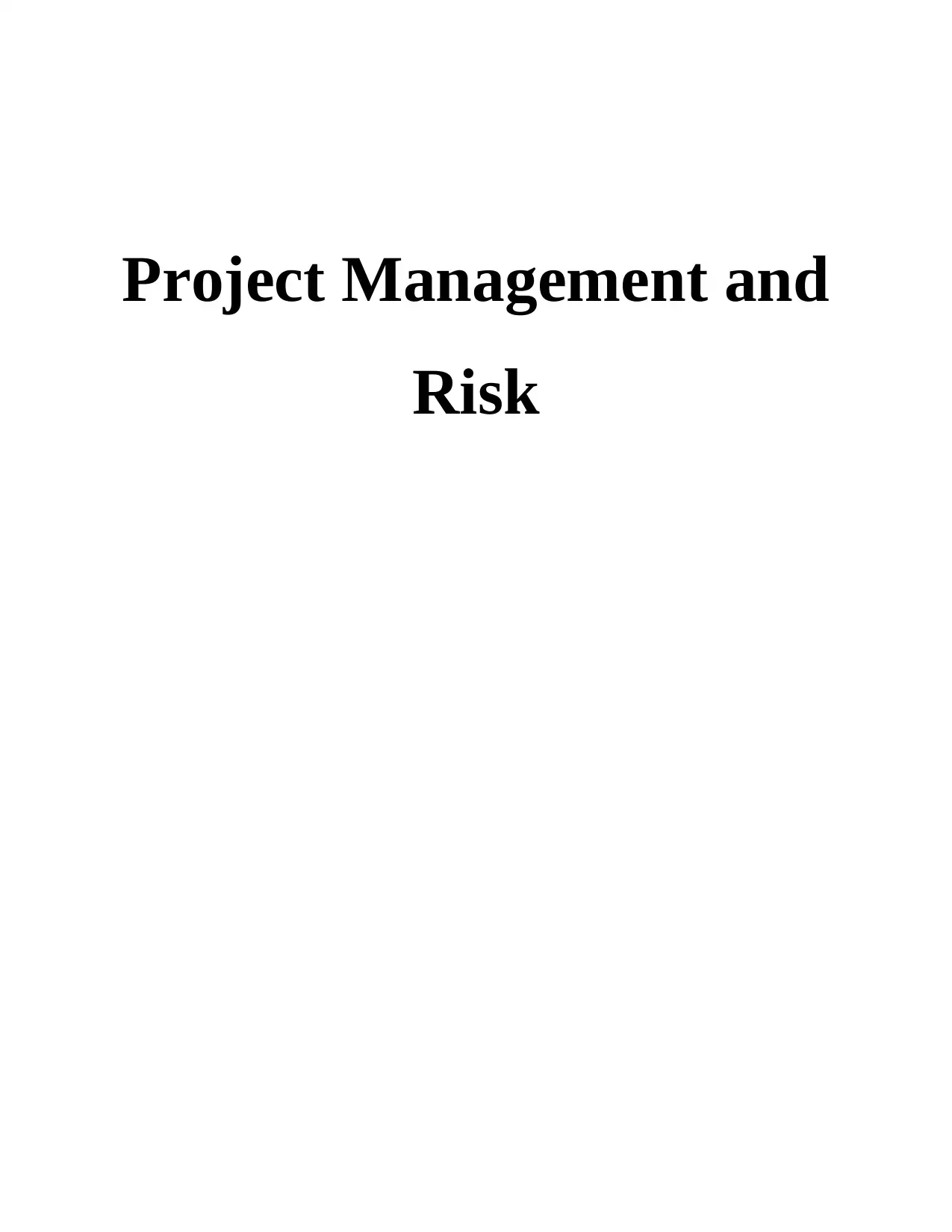
Project Management and
Risk
Risk
Secure Best Marks with AI Grader
Need help grading? Try our AI Grader for instant feedback on your assignments.

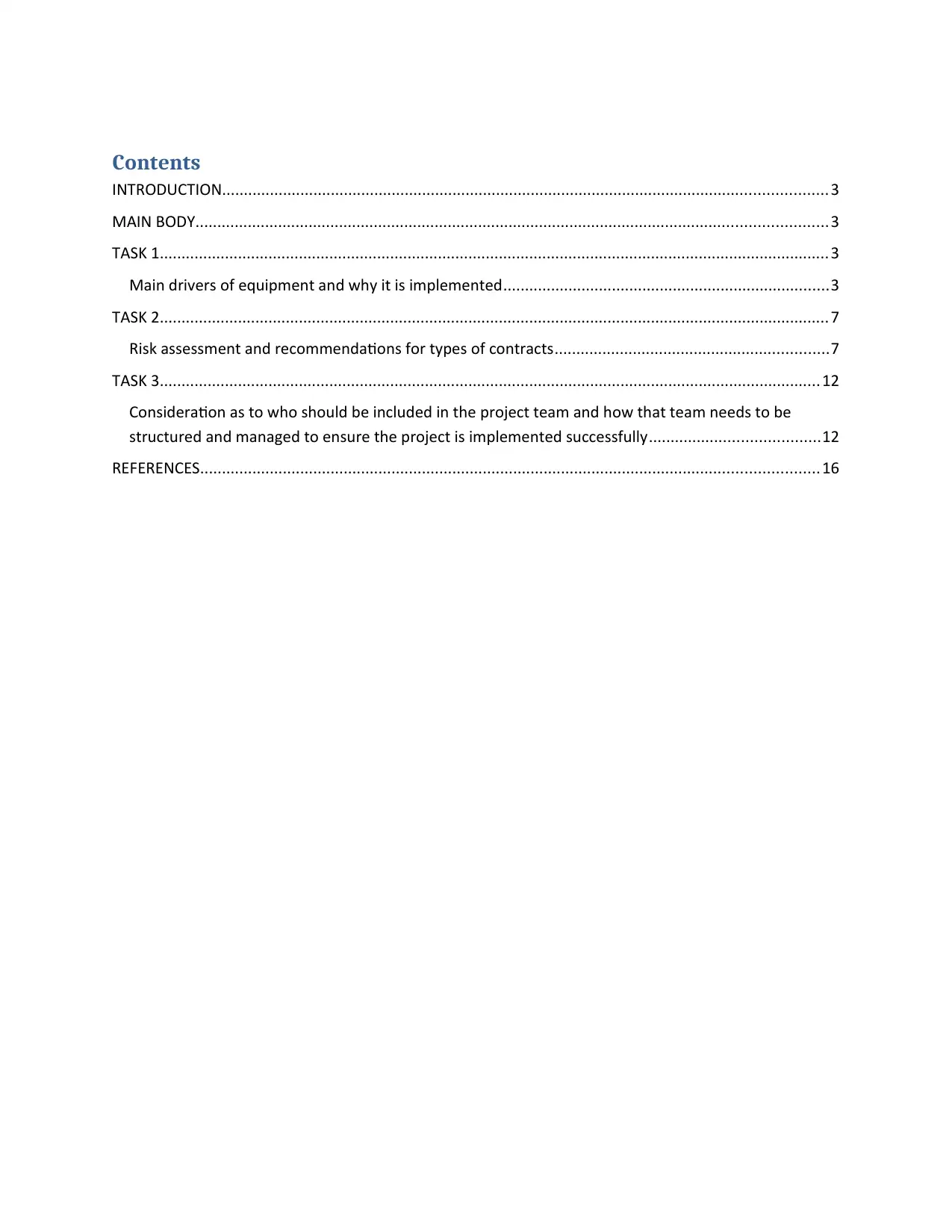
Contents
INTRODUCTION...........................................................................................................................................3
MAIN BODY.................................................................................................................................................3
TASK 1..........................................................................................................................................................3
Main drivers of equipment and why it is implemented...........................................................................3
TASK 2..........................................................................................................................................................7
Risk assessment and recommendations for types of contracts...............................................................7
TASK 3........................................................................................................................................................12
Consideration as to who should be included in the project team and how that team needs to be
structured and managed to ensure the project is implemented successfully.......................................12
REFERENCES..............................................................................................................................................16
INTRODUCTION...........................................................................................................................................3
MAIN BODY.................................................................................................................................................3
TASK 1..........................................................................................................................................................3
Main drivers of equipment and why it is implemented...........................................................................3
TASK 2..........................................................................................................................................................7
Risk assessment and recommendations for types of contracts...............................................................7
TASK 3........................................................................................................................................................12
Consideration as to who should be included in the project team and how that team needs to be
structured and managed to ensure the project is implemented successfully.......................................12
REFERENCES..............................................................................................................................................16
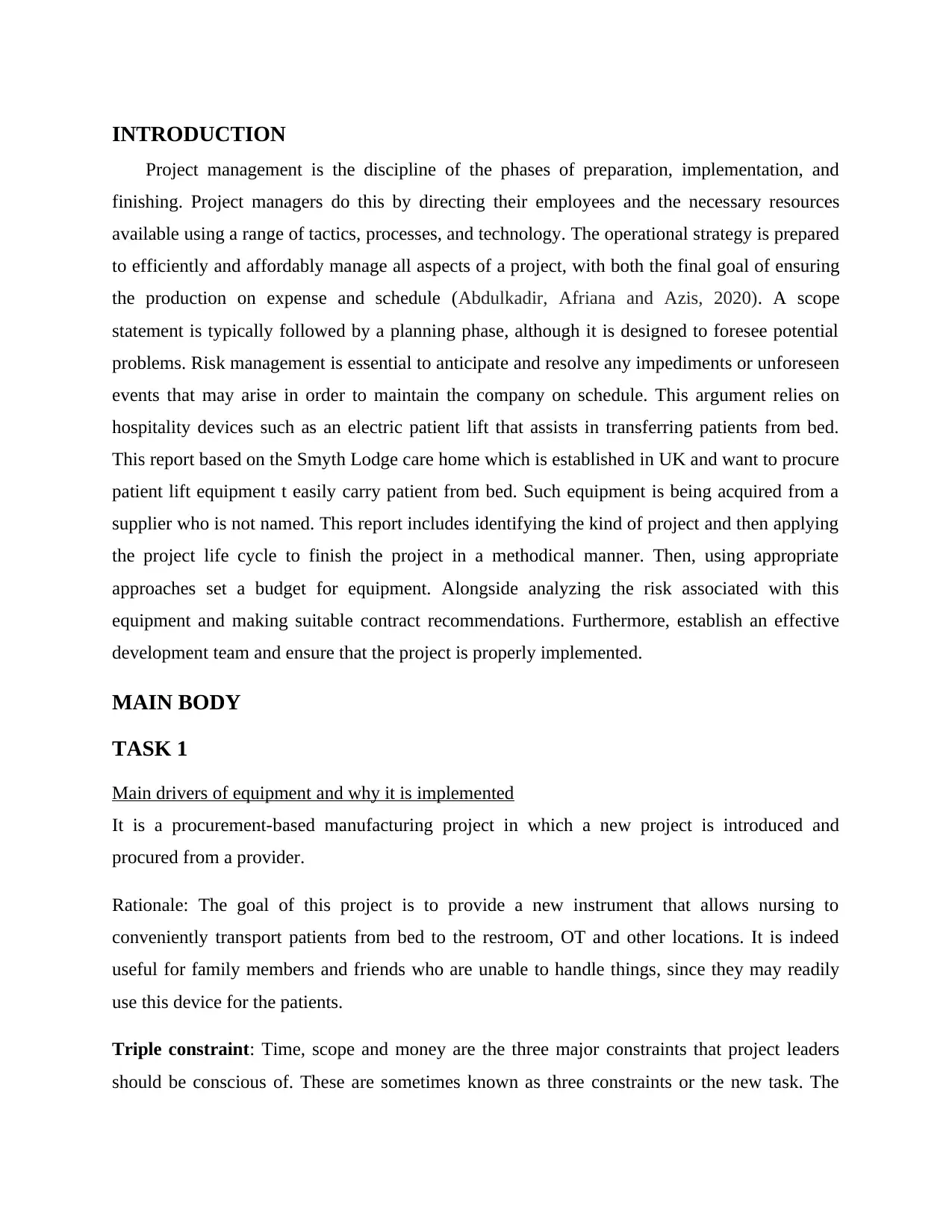
INTRODUCTION
Project management is the discipline of the phases of preparation, implementation, and
finishing. Project managers do this by directing their employees and the necessary resources
available using a range of tactics, processes, and technology. The operational strategy is prepared
to efficiently and affordably manage all aspects of a project, with both the final goal of ensuring
the production on expense and schedule (Abdulkadir, Afriana and Azis, 2020). A scope
statement is typically followed by a planning phase, although it is designed to foresee potential
problems. Risk management is essential to anticipate and resolve any impediments or unforeseen
events that may arise in order to maintain the company on schedule. This argument relies on
hospitality devices such as an electric patient lift that assists in transferring patients from bed.
This report based on the Smyth Lodge care home which is established in UK and want to procure
patient lift equipment t easily carry patient from bed. Such equipment is being acquired from a
supplier who is not named. This report includes identifying the kind of project and then applying
the project life cycle to finish the project in a methodical manner. Then, using appropriate
approaches set a budget for equipment. Alongside analyzing the risk associated with this
equipment and making suitable contract recommendations. Furthermore, establish an effective
development team and ensure that the project is properly implemented.
MAIN BODY
TASK 1
Main drivers of equipment and why it is implemented
It is a procurement-based manufacturing project in which a new project is introduced and
procured from a provider.
Rationale: The goal of this project is to provide a new instrument that allows nursing to
conveniently transport patients from bed to the restroom, OT and other locations. It is indeed
useful for family members and friends who are unable to handle things, since they may readily
use this device for the patients.
Triple constraint: Time, scope and money are the three major constraints that project leaders
should be conscious of. These are sometimes known as three constraints or the new task. The
Project management is the discipline of the phases of preparation, implementation, and
finishing. Project managers do this by directing their employees and the necessary resources
available using a range of tactics, processes, and technology. The operational strategy is prepared
to efficiently and affordably manage all aspects of a project, with both the final goal of ensuring
the production on expense and schedule (Abdulkadir, Afriana and Azis, 2020). A scope
statement is typically followed by a planning phase, although it is designed to foresee potential
problems. Risk management is essential to anticipate and resolve any impediments or unforeseen
events that may arise in order to maintain the company on schedule. This argument relies on
hospitality devices such as an electric patient lift that assists in transferring patients from bed.
This report based on the Smyth Lodge care home which is established in UK and want to procure
patient lift equipment t easily carry patient from bed. Such equipment is being acquired from a
supplier who is not named. This report includes identifying the kind of project and then applying
the project life cycle to finish the project in a methodical manner. Then, using appropriate
approaches set a budget for equipment. Alongside analyzing the risk associated with this
equipment and making suitable contract recommendations. Furthermore, establish an effective
development team and ensure that the project is properly implemented.
MAIN BODY
TASK 1
Main drivers of equipment and why it is implemented
It is a procurement-based manufacturing project in which a new project is introduced and
procured from a provider.
Rationale: The goal of this project is to provide a new instrument that allows nursing to
conveniently transport patients from bed to the restroom, OT and other locations. It is indeed
useful for family members and friends who are unable to handle things, since they may readily
use this device for the patients.
Triple constraint: Time, scope and money are the three major constraints that project leaders
should be conscious of. These are sometimes known as three constraints or the new task. The
Secure Best Marks with AI Grader
Need help grading? Try our AI Grader for instant feedback on your assignments.
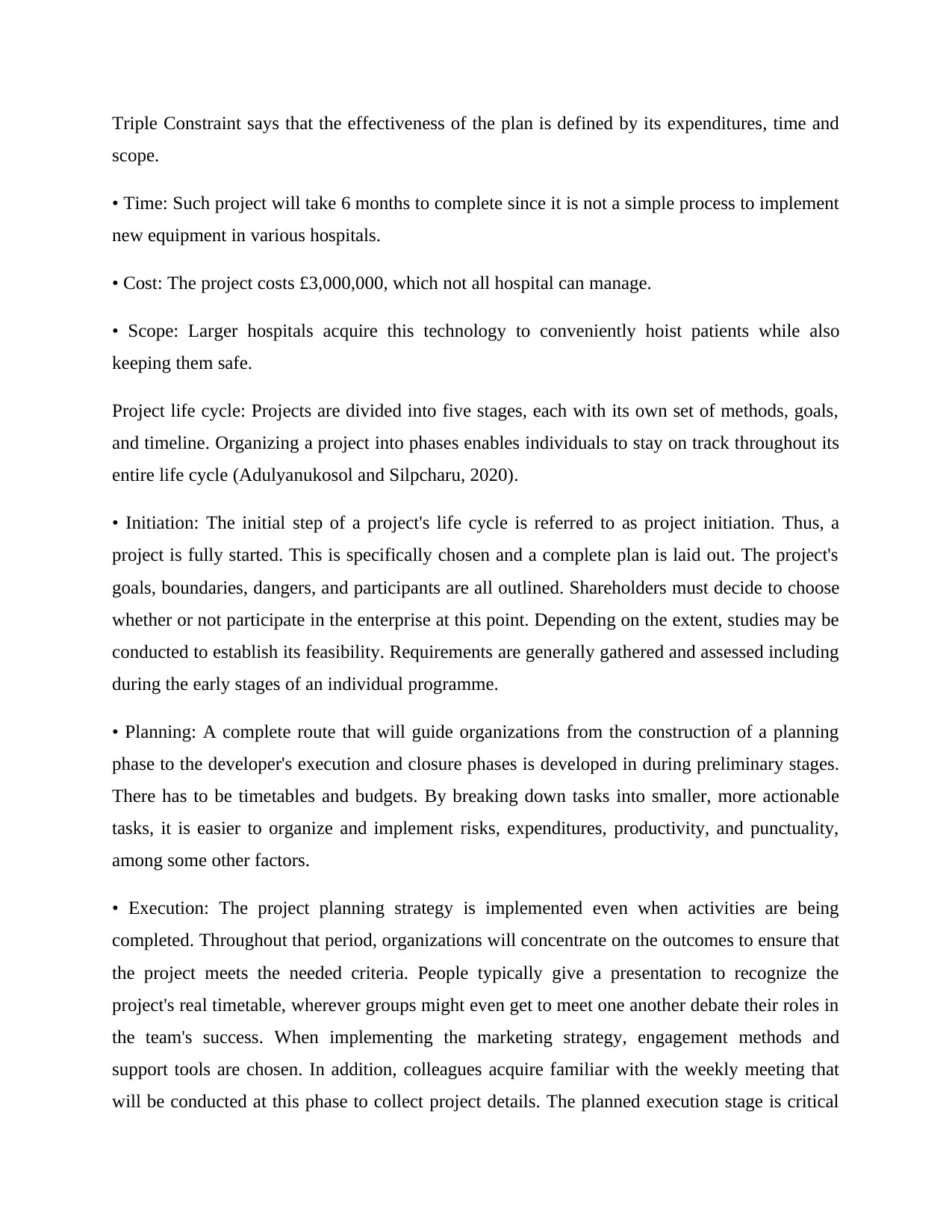
Triple Constraint says that the effectiveness of the plan is defined by its expenditures, time and
scope.
• Time: Such project will take 6 months to complete since it is not a simple process to implement
new equipment in various hospitals.
• Cost: The project costs £3,000,000, which not all hospital can manage.
• Scope: Larger hospitals acquire this technology to conveniently hoist patients while also
keeping them safe.
Project life cycle: Projects are divided into five stages, each with its own set of methods, goals,
and timeline. Organizing a project into phases enables individuals to stay on track throughout its
entire life cycle (Adulyanukosol and Silpcharu, 2020).
• Initiation: The initial step of a project's life cycle is referred to as project initiation. Thus, a
project is fully started. This is specifically chosen and a complete plan is laid out. The project's
goals, boundaries, dangers, and participants are all outlined. Shareholders must decide to choose
whether or not participate in the enterprise at this point. Depending on the extent, studies may be
conducted to establish its feasibility. Requirements are generally gathered and assessed including
during the early stages of an individual programme.
• Planning: A complete route that will guide organizations from the construction of a planning
phase to the developer's execution and closure phases is developed in during preliminary stages.
There has to be timetables and budgets. By breaking down tasks into smaller, more actionable
tasks, it is easier to organize and implement risks, expenditures, productivity, and punctuality,
among some other factors.
• Execution: The project planning strategy is implemented even when activities are being
completed. Throughout that period, organizations will concentrate on the outcomes to ensure that
the project meets the needed criteria. People typically give a presentation to recognize the
project's real timetable, wherever groups might even get to meet one another debate their roles in
the team's success. When implementing the marketing strategy, engagement methods and
support tools are chosen. In addition, colleagues acquire familiar with the weekly meeting that
will be conducted at this phase to collect project details. The planned execution stage is critical
scope.
• Time: Such project will take 6 months to complete since it is not a simple process to implement
new equipment in various hospitals.
• Cost: The project costs £3,000,000, which not all hospital can manage.
• Scope: Larger hospitals acquire this technology to conveniently hoist patients while also
keeping them safe.
Project life cycle: Projects are divided into five stages, each with its own set of methods, goals,
and timeline. Organizing a project into phases enables individuals to stay on track throughout its
entire life cycle (Adulyanukosol and Silpcharu, 2020).
• Initiation: The initial step of a project's life cycle is referred to as project initiation. Thus, a
project is fully started. This is specifically chosen and a complete plan is laid out. The project's
goals, boundaries, dangers, and participants are all outlined. Shareholders must decide to choose
whether or not participate in the enterprise at this point. Depending on the extent, studies may be
conducted to establish its feasibility. Requirements are generally gathered and assessed including
during the early stages of an individual programme.
• Planning: A complete route that will guide organizations from the construction of a planning
phase to the developer's execution and closure phases is developed in during preliminary stages.
There has to be timetables and budgets. By breaking down tasks into smaller, more actionable
tasks, it is easier to organize and implement risks, expenditures, productivity, and punctuality,
among some other factors.
• Execution: The project planning strategy is implemented even when activities are being
completed. Throughout that period, organizations will concentrate on the outcomes to ensure that
the project meets the needed criteria. People typically give a presentation to recognize the
project's real timetable, wherever groups might even get to meet one another debate their roles in
the team's success. When implementing the marketing strategy, engagement methods and
support tools are chosen. In addition, colleagues acquire familiar with the weekly meeting that
will be conducted at this phase to collect project details. The planned execution stage is critical
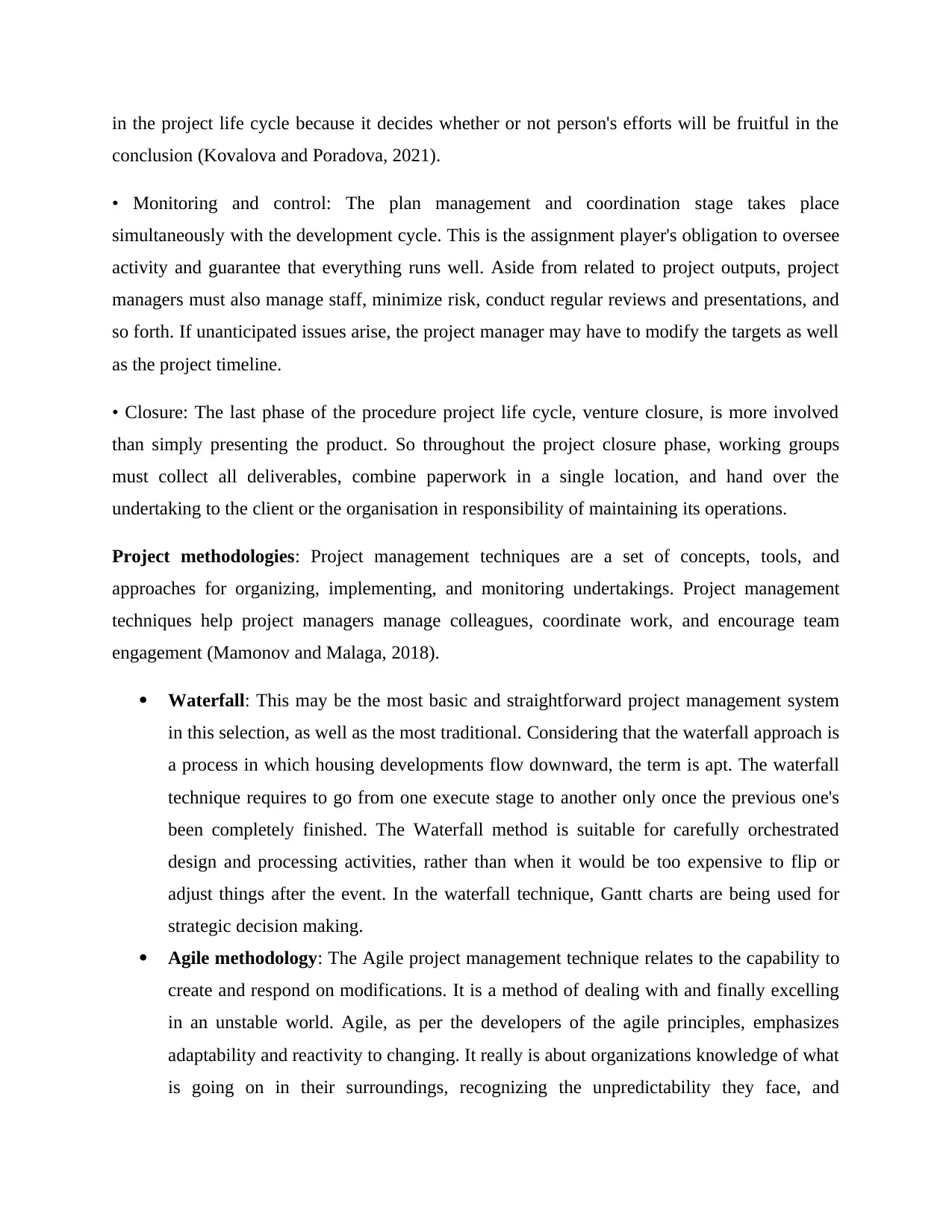
in the project life cycle because it decides whether or not person's efforts will be fruitful in the
conclusion (Kovalova and Poradova, 2021).
• Monitoring and control: The plan management and coordination stage takes place
simultaneously with the development cycle. This is the assignment player's obligation to oversee
activity and guarantee that everything runs well. Aside from related to project outputs, project
managers must also manage staff, minimize risk, conduct regular reviews and presentations, and
so forth. If unanticipated issues arise, the project manager may have to modify the targets as well
as the project timeline.
• Closure: The last phase of the procedure project life cycle, venture closure, is more involved
than simply presenting the product. So throughout the project closure phase, working groups
must collect all deliverables, combine paperwork in a single location, and hand over the
undertaking to the client or the organisation in responsibility of maintaining its operations.
Project methodologies: Project management techniques are a set of concepts, tools, and
approaches for organizing, implementing, and monitoring undertakings. Project management
techniques help project managers manage colleagues, coordinate work, and encourage team
engagement (Mamonov and Malaga, 2018).
Waterfall: This may be the most basic and straightforward project management system
in this selection, as well as the most traditional. Considering that the waterfall approach is
a process in which housing developments flow downward, the term is apt. The waterfall
technique requires to go from one execute stage to another only once the previous one's
been completely finished. The Waterfall method is suitable for carefully orchestrated
design and processing activities, rather than when it would be too expensive to flip or
adjust things after the event. In the waterfall technique, Gantt charts are being used for
strategic decision making.
Agile methodology: The Agile project management technique relates to the capability to
create and respond on modifications. It is a method of dealing with and finally excelling
in an unstable world. Agile, as per the developers of the agile principles, emphasizes
adaptability and reactivity to changing. It really is about organizations knowledge of what
is going on in their surroundings, recognizing the unpredictability they face, and
conclusion (Kovalova and Poradova, 2021).
• Monitoring and control: The plan management and coordination stage takes place
simultaneously with the development cycle. This is the assignment player's obligation to oversee
activity and guarantee that everything runs well. Aside from related to project outputs, project
managers must also manage staff, minimize risk, conduct regular reviews and presentations, and
so forth. If unanticipated issues arise, the project manager may have to modify the targets as well
as the project timeline.
• Closure: The last phase of the procedure project life cycle, venture closure, is more involved
than simply presenting the product. So throughout the project closure phase, working groups
must collect all deliverables, combine paperwork in a single location, and hand over the
undertaking to the client or the organisation in responsibility of maintaining its operations.
Project methodologies: Project management techniques are a set of concepts, tools, and
approaches for organizing, implementing, and monitoring undertakings. Project management
techniques help project managers manage colleagues, coordinate work, and encourage team
engagement (Mamonov and Malaga, 2018).
Waterfall: This may be the most basic and straightforward project management system
in this selection, as well as the most traditional. Considering that the waterfall approach is
a process in which housing developments flow downward, the term is apt. The waterfall
technique requires to go from one execute stage to another only once the previous one's
been completely finished. The Waterfall method is suitable for carefully orchestrated
design and processing activities, rather than when it would be too expensive to flip or
adjust things after the event. In the waterfall technique, Gantt charts are being used for
strategic decision making.
Agile methodology: The Agile project management technique relates to the capability to
create and respond on modifications. It is a method of dealing with and finally excelling
in an unstable world. Agile, as per the developers of the agile principles, emphasizes
adaptability and reactivity to changing. It really is about organizations knowledge of what
is going on in their surroundings, recognizing the unpredictability they face, and
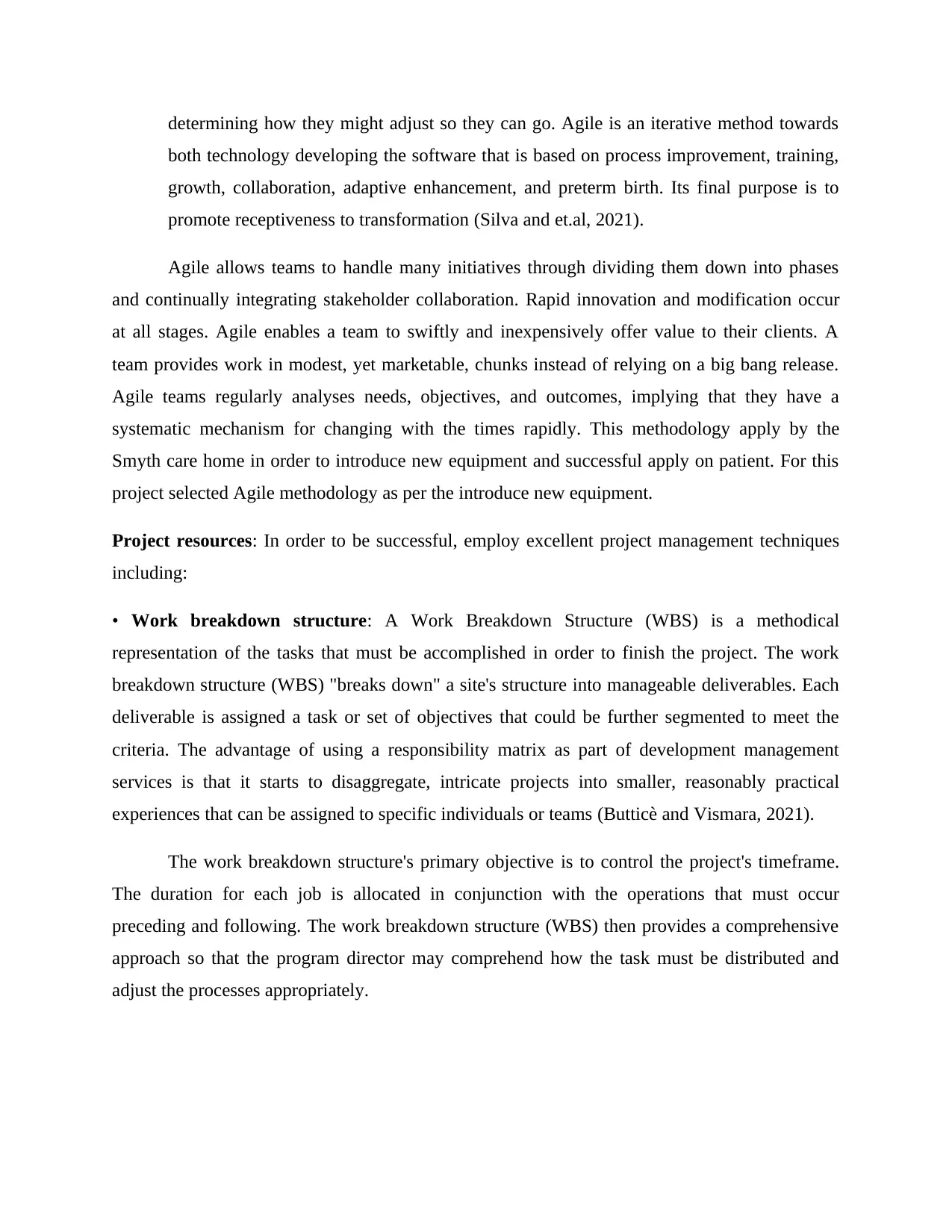
determining how they might adjust so they can go. Agile is an iterative method towards
both technology developing the software that is based on process improvement, training,
growth, collaboration, adaptive enhancement, and preterm birth. Its final purpose is to
promote receptiveness to transformation (Silva and et.al, 2021).
Agile allows teams to handle many initiatives through dividing them down into phases
and continually integrating stakeholder collaboration. Rapid innovation and modification occur
at all stages. Agile enables a team to swiftly and inexpensively offer value to their clients. A
team provides work in modest, yet marketable, chunks instead of relying on a big bang release.
Agile teams regularly analyses needs, objectives, and outcomes, implying that they have a
systematic mechanism for changing with the times rapidly. This methodology apply by the
Smyth care home in order to introduce new equipment and successful apply on patient. For this
project selected Agile methodology as per the introduce new equipment.
Project resources: In order to be successful, employ excellent project management techniques
including:
• Work breakdown structure: A Work Breakdown Structure (WBS) is a methodical
representation of the tasks that must be accomplished in order to finish the project. The work
breakdown structure (WBS) "breaks down" a site's structure into manageable deliverables. Each
deliverable is assigned a task or set of objectives that could be further segmented to meet the
criteria. The advantage of using a responsibility matrix as part of development management
services is that it starts to disaggregate, intricate projects into smaller, reasonably practical
experiences that can be assigned to specific individuals or teams (Butticè and Vismara, 2021).
The work breakdown structure's primary objective is to control the project's timeframe.
The duration for each job is allocated in conjunction with the operations that must occur
preceding and following. The work breakdown structure (WBS) then provides a comprehensive
approach so that the program director may comprehend how the task must be distributed and
adjust the processes appropriately.
both technology developing the software that is based on process improvement, training,
growth, collaboration, adaptive enhancement, and preterm birth. Its final purpose is to
promote receptiveness to transformation (Silva and et.al, 2021).
Agile allows teams to handle many initiatives through dividing them down into phases
and continually integrating stakeholder collaboration. Rapid innovation and modification occur
at all stages. Agile enables a team to swiftly and inexpensively offer value to their clients. A
team provides work in modest, yet marketable, chunks instead of relying on a big bang release.
Agile teams regularly analyses needs, objectives, and outcomes, implying that they have a
systematic mechanism for changing with the times rapidly. This methodology apply by the
Smyth care home in order to introduce new equipment and successful apply on patient. For this
project selected Agile methodology as per the introduce new equipment.
Project resources: In order to be successful, employ excellent project management techniques
including:
• Work breakdown structure: A Work Breakdown Structure (WBS) is a methodical
representation of the tasks that must be accomplished in order to finish the project. The work
breakdown structure (WBS) "breaks down" a site's structure into manageable deliverables. Each
deliverable is assigned a task or set of objectives that could be further segmented to meet the
criteria. The advantage of using a responsibility matrix as part of development management
services is that it starts to disaggregate, intricate projects into smaller, reasonably practical
experiences that can be assigned to specific individuals or teams (Butticè and Vismara, 2021).
The work breakdown structure's primary objective is to control the project's timeframe.
The duration for each job is allocated in conjunction with the operations that must occur
preceding and following. The work breakdown structure (WBS) then provides a comprehensive
approach so that the program director may comprehend how the task must be distributed and
adjust the processes appropriately.
Paraphrase This Document
Need a fresh take? Get an instant paraphrase of this document with our AI Paraphraser
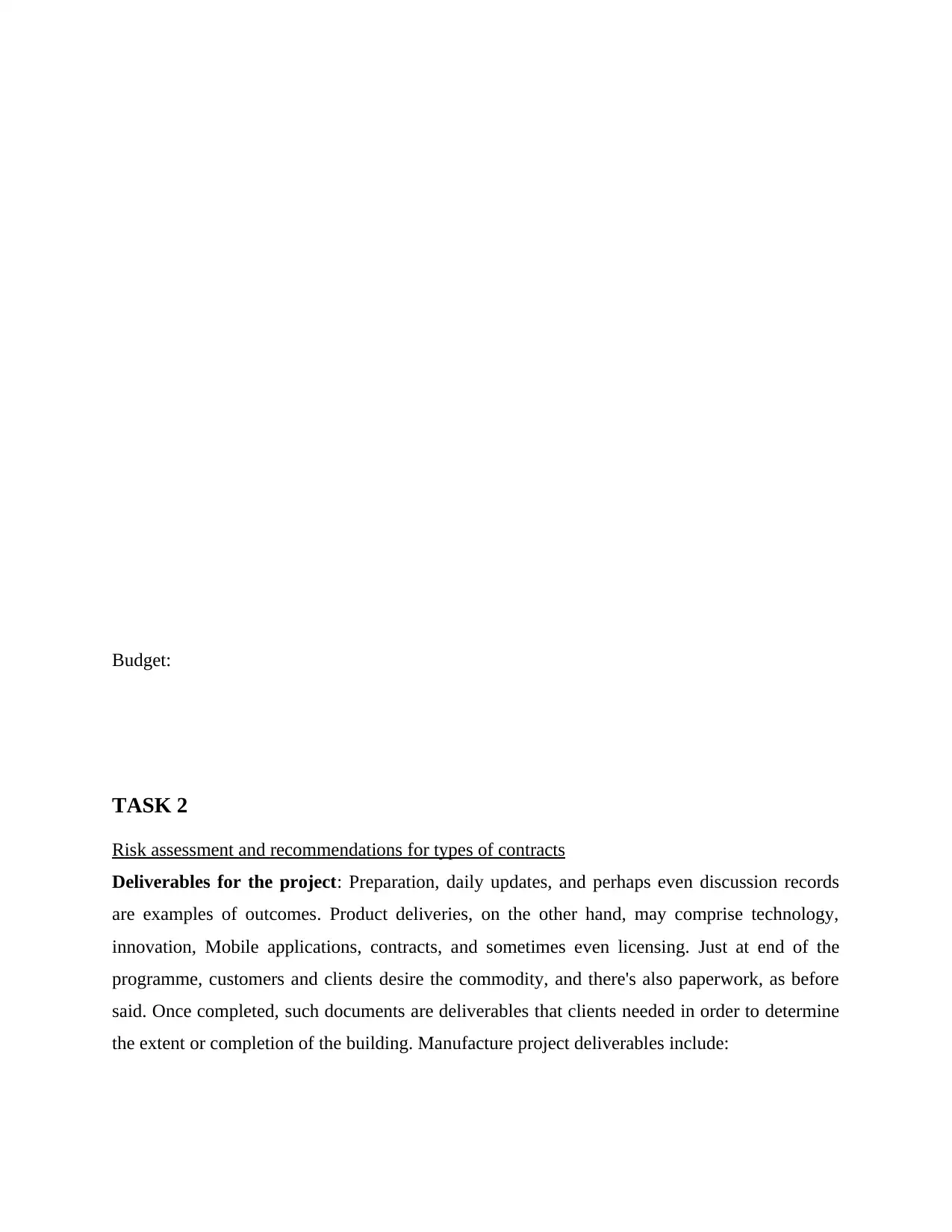
Budget:
TASK 2
Risk assessment and recommendations for types of contracts
Deliverables for the project: Preparation, daily updates, and perhaps even discussion records
are examples of outcomes. Product deliveries, on the other hand, may comprise technology,
innovation, Mobile applications, contracts, and sometimes even licensing. Just at end of the
programme, customers and clients desire the commodity, and there's also paperwork, as before
said. Once completed, such documents are deliverables that clients needed in order to determine
the extent or completion of the building. Manufacture project deliverables include:
IntroductionBackgroundcosttimescopequalityresourcesResearchmethodsDataanalysisoutliningthemesmakinggraphsinterpretingthedataconcludingfinding
TASK 2
Risk assessment and recommendations for types of contracts
Deliverables for the project: Preparation, daily updates, and perhaps even discussion records
are examples of outcomes. Product deliveries, on the other hand, may comprise technology,
innovation, Mobile applications, contracts, and sometimes even licensing. Just at end of the
programme, customers and clients desire the commodity, and there's also paperwork, as before
said. Once completed, such documents are deliverables that clients needed in order to determine
the extent or completion of the building. Manufacture project deliverables include:
IntroductionBackgroundcosttimescopequalityresourcesResearchmethodsDataanalysisoutliningthemesmakinggraphsinterpretingthedataconcludingfinding
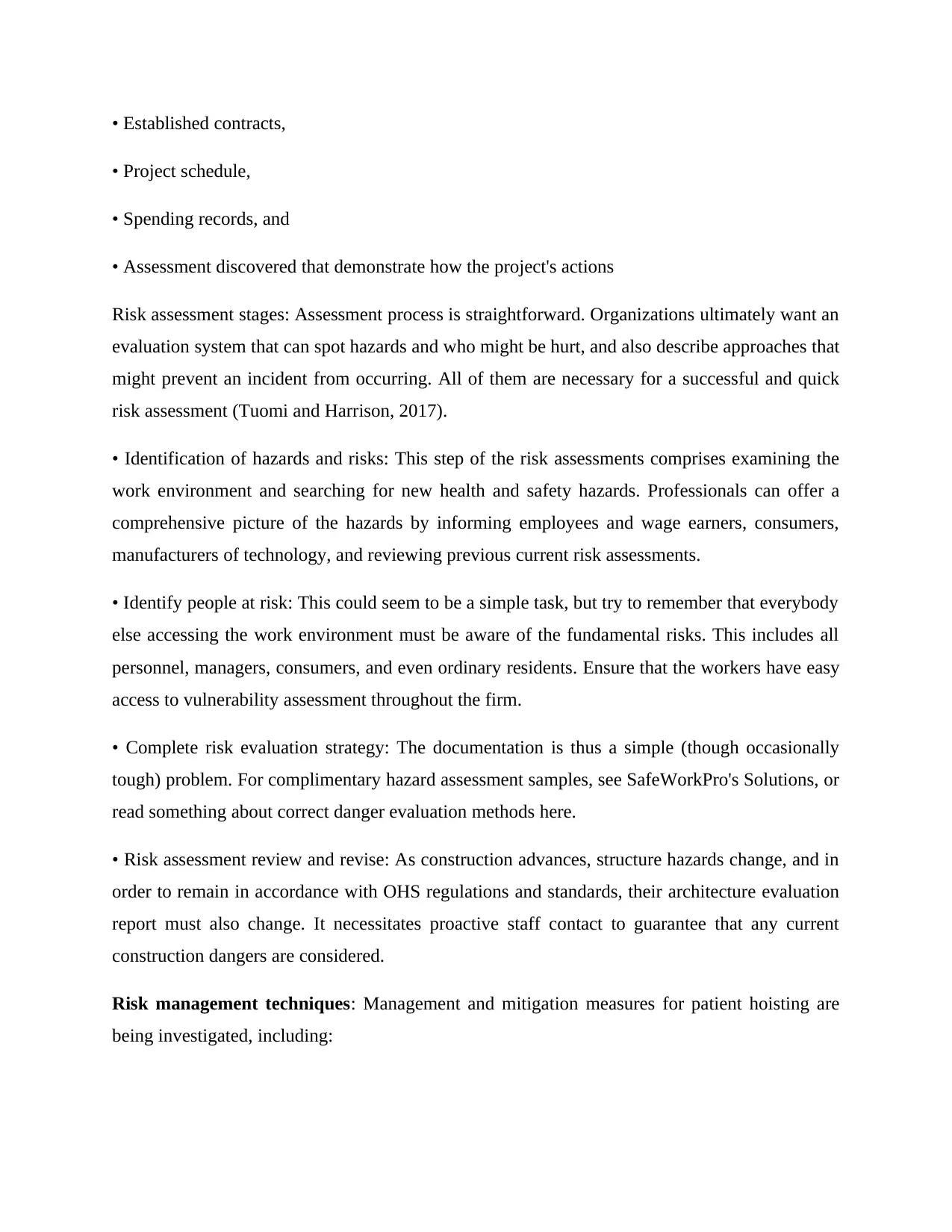
• Established contracts,
• Project schedule,
• Spending records, and
• Assessment discovered that demonstrate how the project's actions
Risk assessment stages: Assessment process is straightforward. Organizations ultimately want an
evaluation system that can spot hazards and who might be hurt, and also describe approaches that
might prevent an incident from occurring. All of them are necessary for a successful and quick
risk assessment (Tuomi and Harrison, 2017).
• Identification of hazards and risks: This step of the risk assessments comprises examining the
work environment and searching for new health and safety hazards. Professionals can offer a
comprehensive picture of the hazards by informing employees and wage earners, consumers,
manufacturers of technology, and reviewing previous current risk assessments.
• Identify people at risk: This could seem to be a simple task, but try to remember that everybody
else accessing the work environment must be aware of the fundamental risks. This includes all
personnel, managers, consumers, and even ordinary residents. Ensure that the workers have easy
access to vulnerability assessment throughout the firm.
• Complete risk evaluation strategy: The documentation is thus a simple (though occasionally
tough) problem. For complimentary hazard assessment samples, see SafeWorkPro's Solutions, or
read something about correct danger evaluation methods here.
• Risk assessment review and revise: As construction advances, structure hazards change, and in
order to remain in accordance with OHS regulations and standards, their architecture evaluation
report must also change. It necessitates proactive staff contact to guarantee that any current
construction dangers are considered.
Risk management techniques: Management and mitigation measures for patient hoisting are
being investigated, including:
• Project schedule,
• Spending records, and
• Assessment discovered that demonstrate how the project's actions
Risk assessment stages: Assessment process is straightforward. Organizations ultimately want an
evaluation system that can spot hazards and who might be hurt, and also describe approaches that
might prevent an incident from occurring. All of them are necessary for a successful and quick
risk assessment (Tuomi and Harrison, 2017).
• Identification of hazards and risks: This step of the risk assessments comprises examining the
work environment and searching for new health and safety hazards. Professionals can offer a
comprehensive picture of the hazards by informing employees and wage earners, consumers,
manufacturers of technology, and reviewing previous current risk assessments.
• Identify people at risk: This could seem to be a simple task, but try to remember that everybody
else accessing the work environment must be aware of the fundamental risks. This includes all
personnel, managers, consumers, and even ordinary residents. Ensure that the workers have easy
access to vulnerability assessment throughout the firm.
• Complete risk evaluation strategy: The documentation is thus a simple (though occasionally
tough) problem. For complimentary hazard assessment samples, see SafeWorkPro's Solutions, or
read something about correct danger evaluation methods here.
• Risk assessment review and revise: As construction advances, structure hazards change, and in
order to remain in accordance with OHS regulations and standards, their architecture evaluation
report must also change. It necessitates proactive staff contact to guarantee that any current
construction dangers are considered.
Risk management techniques: Management and mitigation measures for patient hoisting are
being investigated, including:
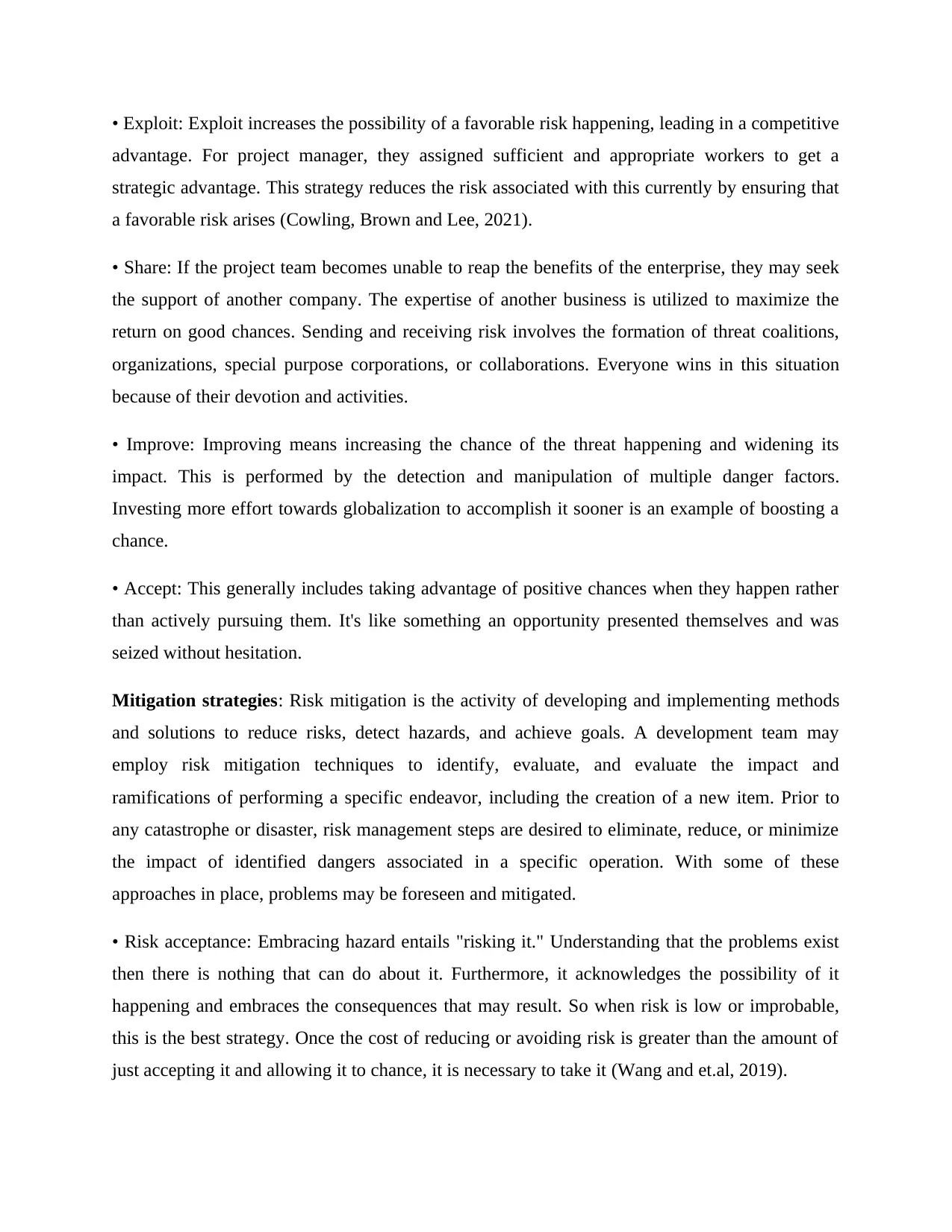
• Exploit: Exploit increases the possibility of a favorable risk happening, leading in a competitive
advantage. For project manager, they assigned sufficient and appropriate workers to get a
strategic advantage. This strategy reduces the risk associated with this currently by ensuring that
a favorable risk arises (Cowling, Brown and Lee, 2021).
• Share: If the project team becomes unable to reap the benefits of the enterprise, they may seek
the support of another company. The expertise of another business is utilized to maximize the
return on good chances. Sending and receiving risk involves the formation of threat coalitions,
organizations, special purpose corporations, or collaborations. Everyone wins in this situation
because of their devotion and activities.
• Improve: Improving means increasing the chance of the threat happening and widening its
impact. This is performed by the detection and manipulation of multiple danger factors.
Investing more effort towards globalization to accomplish it sooner is an example of boosting a
chance.
• Accept: This generally includes taking advantage of positive chances when they happen rather
than actively pursuing them. It's like something an opportunity presented themselves and was
seized without hesitation.
Mitigation strategies: Risk mitigation is the activity of developing and implementing methods
and solutions to reduce risks, detect hazards, and achieve goals. A development team may
employ risk mitigation techniques to identify, evaluate, and evaluate the impact and
ramifications of performing a specific endeavor, including the creation of a new item. Prior to
any catastrophe or disaster, risk management steps are desired to eliminate, reduce, or minimize
the impact of identified dangers associated in a specific operation. With some of these
approaches in place, problems may be foreseen and mitigated.
• Risk acceptance: Embracing hazard entails "risking it." Understanding that the problems exist
then there is nothing that can do about it. Furthermore, it acknowledges the possibility of it
happening and embraces the consequences that may result. So when risk is low or improbable,
this is the best strategy. Once the cost of reducing or avoiding risk is greater than the amount of
just accepting it and allowing it to chance, it is necessary to take it (Wang and et.al, 2019).
advantage. For project manager, they assigned sufficient and appropriate workers to get a
strategic advantage. This strategy reduces the risk associated with this currently by ensuring that
a favorable risk arises (Cowling, Brown and Lee, 2021).
• Share: If the project team becomes unable to reap the benefits of the enterprise, they may seek
the support of another company. The expertise of another business is utilized to maximize the
return on good chances. Sending and receiving risk involves the formation of threat coalitions,
organizations, special purpose corporations, or collaborations. Everyone wins in this situation
because of their devotion and activities.
• Improve: Improving means increasing the chance of the threat happening and widening its
impact. This is performed by the detection and manipulation of multiple danger factors.
Investing more effort towards globalization to accomplish it sooner is an example of boosting a
chance.
• Accept: This generally includes taking advantage of positive chances when they happen rather
than actively pursuing them. It's like something an opportunity presented themselves and was
seized without hesitation.
Mitigation strategies: Risk mitigation is the activity of developing and implementing methods
and solutions to reduce risks, detect hazards, and achieve goals. A development team may
employ risk mitigation techniques to identify, evaluate, and evaluate the impact and
ramifications of performing a specific endeavor, including the creation of a new item. Prior to
any catastrophe or disaster, risk management steps are desired to eliminate, reduce, or minimize
the impact of identified dangers associated in a specific operation. With some of these
approaches in place, problems may be foreseen and mitigated.
• Risk acceptance: Embracing hazard entails "risking it." Understanding that the problems exist
then there is nothing that can do about it. Furthermore, it acknowledges the possibility of it
happening and embraces the consequences that may result. So when risk is low or improbable,
this is the best strategy. Once the cost of reducing or avoiding risk is greater than the amount of
just accepting it and allowing it to chance, it is necessary to take it (Wang and et.al, 2019).
Secure Best Marks with AI Grader
Need help grading? Try our AI Grader for instant feedback on your assignments.
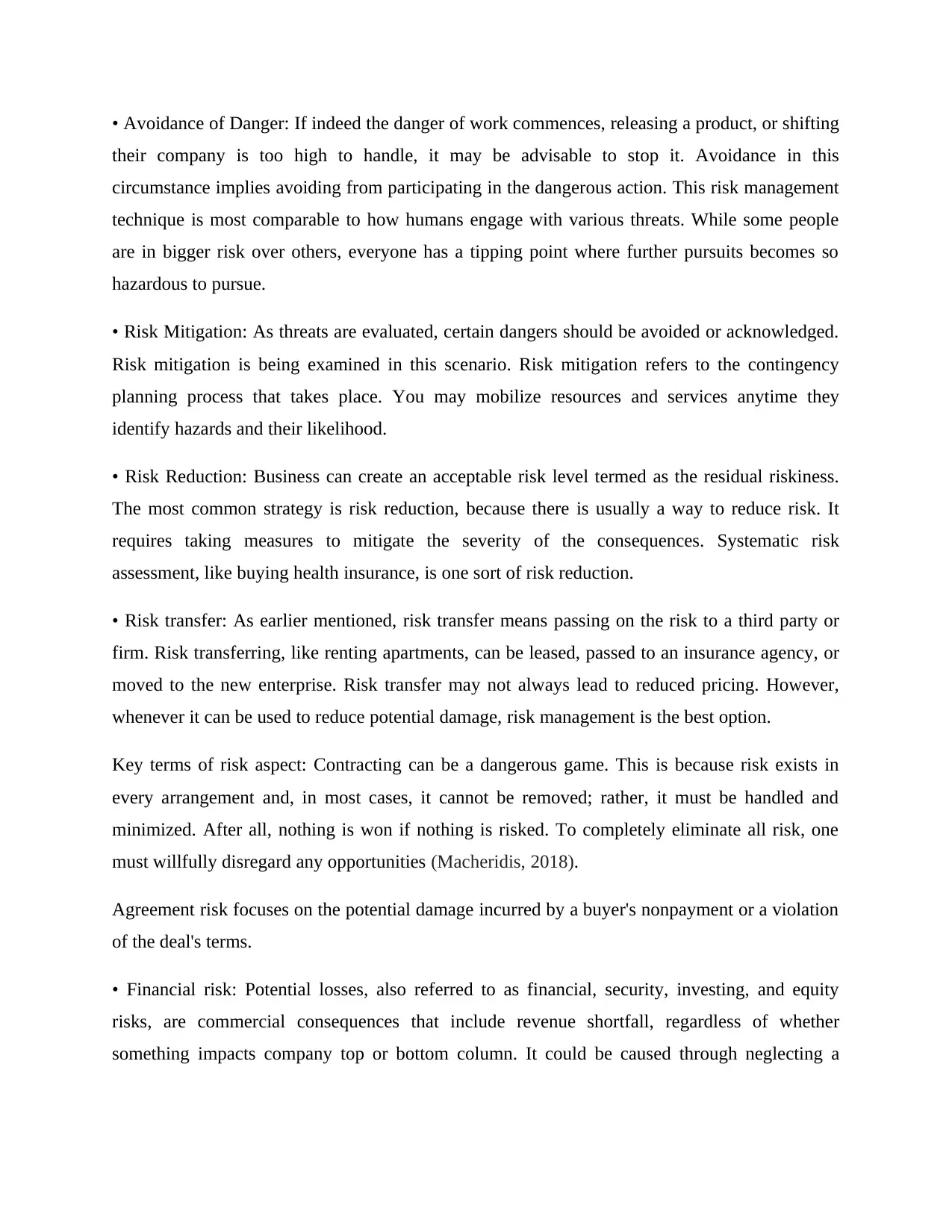
• Avoidance of Danger: If indeed the danger of work commences, releasing a product, or shifting
their company is too high to handle, it may be advisable to stop it. Avoidance in this
circumstance implies avoiding from participating in the dangerous action. This risk management
technique is most comparable to how humans engage with various threats. While some people
are in bigger risk over others, everyone has a tipping point where further pursuits becomes so
hazardous to pursue.
• Risk Mitigation: As threats are evaluated, certain dangers should be avoided or acknowledged.
Risk mitigation is being examined in this scenario. Risk mitigation refers to the contingency
planning process that takes place. You may mobilize resources and services anytime they
identify hazards and their likelihood.
• Risk Reduction: Business can create an acceptable risk level termed as the residual riskiness.
The most common strategy is risk reduction, because there is usually a way to reduce risk. It
requires taking measures to mitigate the severity of the consequences. Systematic risk
assessment, like buying health insurance, is one sort of risk reduction.
• Risk transfer: As earlier mentioned, risk transfer means passing on the risk to a third party or
firm. Risk transferring, like renting apartments, can be leased, passed to an insurance agency, or
moved to the new enterprise. Risk transfer may not always lead to reduced pricing. However,
whenever it can be used to reduce potential damage, risk management is the best option.
Key terms of risk aspect: Contracting can be a dangerous game. This is because risk exists in
every arrangement and, in most cases, it cannot be removed; rather, it must be handled and
minimized. After all, nothing is won if nothing is risked. To completely eliminate all risk, one
must willfully disregard any opportunities (Macheridis, 2018).
Agreement risk focuses on the potential damage incurred by a buyer's nonpayment or a violation
of the deal's terms.
• Financial risk: Potential losses, also referred to as financial, security, investing, and equity
risks, are commercial consequences that include revenue shortfall, regardless of whether
something impacts company top or bottom column. It could be caused through neglecting a
their company is too high to handle, it may be advisable to stop it. Avoidance in this
circumstance implies avoiding from participating in the dangerous action. This risk management
technique is most comparable to how humans engage with various threats. While some people
are in bigger risk over others, everyone has a tipping point where further pursuits becomes so
hazardous to pursue.
• Risk Mitigation: As threats are evaluated, certain dangers should be avoided or acknowledged.
Risk mitigation is being examined in this scenario. Risk mitigation refers to the contingency
planning process that takes place. You may mobilize resources and services anytime they
identify hazards and their likelihood.
• Risk Reduction: Business can create an acceptable risk level termed as the residual riskiness.
The most common strategy is risk reduction, because there is usually a way to reduce risk. It
requires taking measures to mitigate the severity of the consequences. Systematic risk
assessment, like buying health insurance, is one sort of risk reduction.
• Risk transfer: As earlier mentioned, risk transfer means passing on the risk to a third party or
firm. Risk transferring, like renting apartments, can be leased, passed to an insurance agency, or
moved to the new enterprise. Risk transfer may not always lead to reduced pricing. However,
whenever it can be used to reduce potential damage, risk management is the best option.
Key terms of risk aspect: Contracting can be a dangerous game. This is because risk exists in
every arrangement and, in most cases, it cannot be removed; rather, it must be handled and
minimized. After all, nothing is won if nothing is risked. To completely eliminate all risk, one
must willfully disregard any opportunities (Macheridis, 2018).
Agreement risk focuses on the potential damage incurred by a buyer's nonpayment or a violation
of the deal's terms.
• Financial risk: Potential losses, also referred to as financial, security, investing, and equity
risks, are commercial consequences that include revenue shortfall, regardless of whether
something impacts company top or bottom column. It could be caused through neglecting a
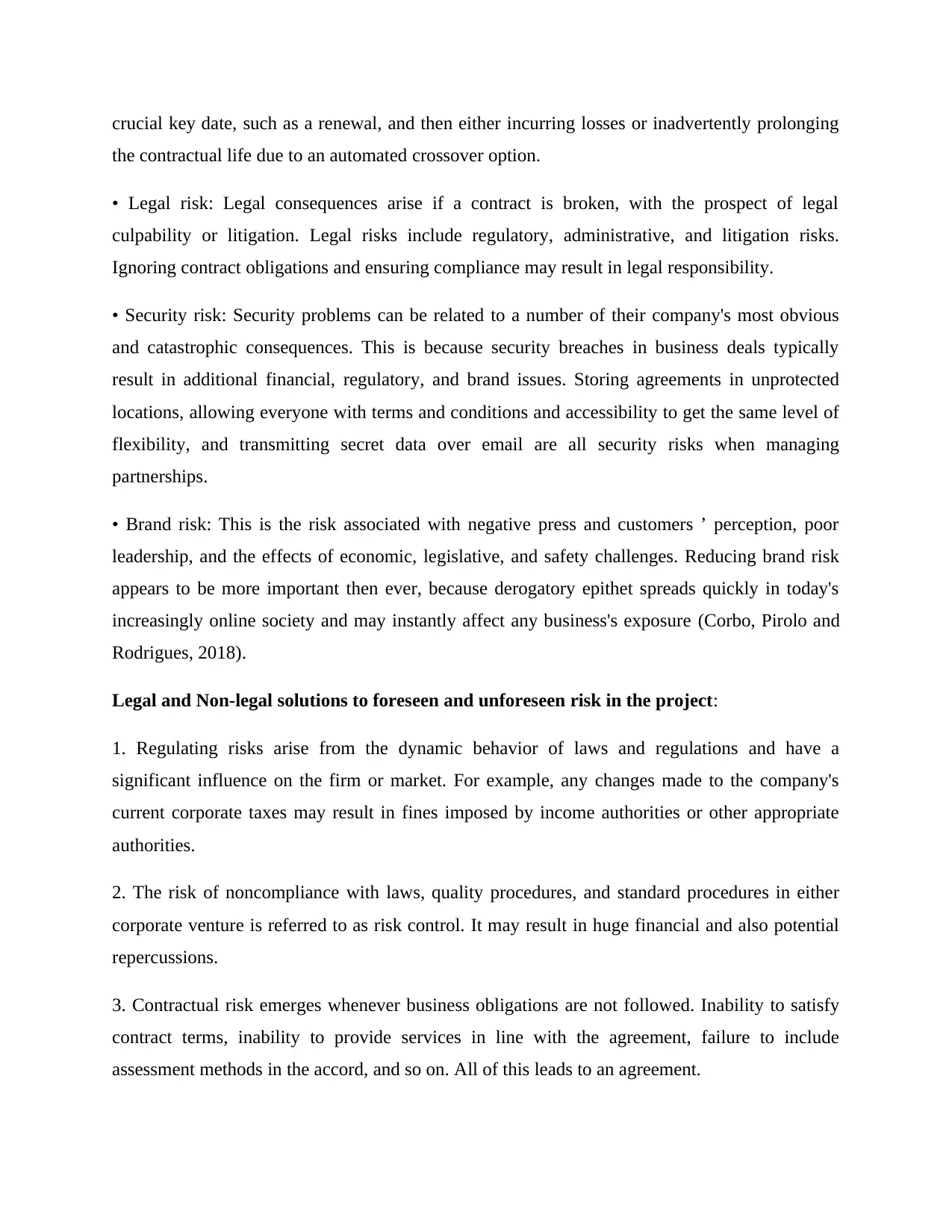
crucial key date, such as a renewal, and then either incurring losses or inadvertently prolonging
the contractual life due to an automated crossover option.
• Legal risk: Legal consequences arise if a contract is broken, with the prospect of legal
culpability or litigation. Legal risks include regulatory, administrative, and litigation risks.
Ignoring contract obligations and ensuring compliance may result in legal responsibility.
• Security risk: Security problems can be related to a number of their company's most obvious
and catastrophic consequences. This is because security breaches in business deals typically
result in additional financial, regulatory, and brand issues. Storing agreements in unprotected
locations, allowing everyone with terms and conditions and accessibility to get the same level of
flexibility, and transmitting secret data over email are all security risks when managing
partnerships.
• Brand risk: This is the risk associated with negative press and customers ’ perception, poor
leadership, and the effects of economic, legislative, and safety challenges. Reducing brand risk
appears to be more important then ever, because derogatory epithet spreads quickly in today's
increasingly online society and may instantly affect any business's exposure (Corbo, Pirolo and
Rodrigues, 2018).
Legal and Non-legal solutions to foreseen and unforeseen risk in the project:
1. Regulating risks arise from the dynamic behavior of laws and regulations and have a
significant influence on the firm or market. For example, any changes made to the company's
current corporate taxes may result in fines imposed by income authorities or other appropriate
authorities.
2. The risk of noncompliance with laws, quality procedures, and standard procedures in either
corporate venture is referred to as risk control. It may result in huge financial and also potential
repercussions.
3. Contractual risk emerges whenever business obligations are not followed. Inability to satisfy
contract terms, inability to provide services in line with the agreement, failure to include
assessment methods in the accord, and so on. All of this leads to an agreement.
the contractual life due to an automated crossover option.
• Legal risk: Legal consequences arise if a contract is broken, with the prospect of legal
culpability or litigation. Legal risks include regulatory, administrative, and litigation risks.
Ignoring contract obligations and ensuring compliance may result in legal responsibility.
• Security risk: Security problems can be related to a number of their company's most obvious
and catastrophic consequences. This is because security breaches in business deals typically
result in additional financial, regulatory, and brand issues. Storing agreements in unprotected
locations, allowing everyone with terms and conditions and accessibility to get the same level of
flexibility, and transmitting secret data over email are all security risks when managing
partnerships.
• Brand risk: This is the risk associated with negative press and customers ’ perception, poor
leadership, and the effects of economic, legislative, and safety challenges. Reducing brand risk
appears to be more important then ever, because derogatory epithet spreads quickly in today's
increasingly online society and may instantly affect any business's exposure (Corbo, Pirolo and
Rodrigues, 2018).
Legal and Non-legal solutions to foreseen and unforeseen risk in the project:
1. Regulating risks arise from the dynamic behavior of laws and regulations and have a
significant influence on the firm or market. For example, any changes made to the company's
current corporate taxes may result in fines imposed by income authorities or other appropriate
authorities.
2. The risk of noncompliance with laws, quality procedures, and standard procedures in either
corporate venture is referred to as risk control. It may result in huge financial and also potential
repercussions.
3. Contractual risk emerges whenever business obligations are not followed. Inability to satisfy
contract terms, inability to provide services in line with the agreement, failure to include
assessment methods in the accord, and so on. All of this leads to an agreement.

4. There is a risk of conflict if investors, customers, or partners disrupt the organisation. These
conflicts might result in lawsuits, placing the company in a difficult position. It is recommended
that problems be handled when they become legal difficulties, as this would incur large costs.
5. Reputational risk refers to the erosion of a firm's spotless image or position as a result of any
shady practices or illegal incident. Employees or other third-party actors, such as merchants, may
cause harm. In contrast to solid governance rules and processes, companies should prioritise
societal responsibilities.
TASK 3
Consideration as to who should be included in the project team and how that team needs to be
structured and managed to ensure the project is implemented successfully
Types of project: There are several kinds of project that are used for various tasks. The
following are some examples:
• Project manufacturing: A projects manufacturer creates large, complicated, specialized things
such as customized residences, military equipment such as boats and fishing vessels, and aircraft
products such as passenger’s aircrafts (Polese and et.al, 2019).
• Construction project: A building project, sometimes referred as a "venture," is the deliberate
activity of constructing, remodeling, or updating a structure, building, or infrastructure.
• Management project: This comprises work arrangements or restructuring that may not result in
a complete physical result. Examples include the research and refinement of a new computer
software system, the relocation of a corporate office, and the production of a stage show.
• Research project: In terms of completeness, a great research proposal will be approachable. The
quantity of available resources for study will decide the breadth. In general, the more specific the
research questions, the more likely the project were successful.
Project initiation and team selection: The first phase in the project management plan is for
enterprises to decide if the idea is essential and how useful it'll be to customers. The economic
justification and design development are two methods used to analyze and define requirements
for new proposals.
conflicts might result in lawsuits, placing the company in a difficult position. It is recommended
that problems be handled when they become legal difficulties, as this would incur large costs.
5. Reputational risk refers to the erosion of a firm's spotless image or position as a result of any
shady practices or illegal incident. Employees or other third-party actors, such as merchants, may
cause harm. In contrast to solid governance rules and processes, companies should prioritise
societal responsibilities.
TASK 3
Consideration as to who should be included in the project team and how that team needs to be
structured and managed to ensure the project is implemented successfully
Types of project: There are several kinds of project that are used for various tasks. The
following are some examples:
• Project manufacturing: A projects manufacturer creates large, complicated, specialized things
such as customized residences, military equipment such as boats and fishing vessels, and aircraft
products such as passenger’s aircrafts (Polese and et.al, 2019).
• Construction project: A building project, sometimes referred as a "venture," is the deliberate
activity of constructing, remodeling, or updating a structure, building, or infrastructure.
• Management project: This comprises work arrangements or restructuring that may not result in
a complete physical result. Examples include the research and refinement of a new computer
software system, the relocation of a corporate office, and the production of a stage show.
• Research project: In terms of completeness, a great research proposal will be approachable. The
quantity of available resources for study will decide the breadth. In general, the more specific the
research questions, the more likely the project were successful.
Project initiation and team selection: The first phase in the project management plan is for
enterprises to decide if the idea is essential and how useful it'll be to customers. The economic
justification and design development are two methods used to analyze and define requirements
for new proposals.
Paraphrase This Document
Need a fresh take? Get an instant paraphrase of this document with our AI Paraphraser
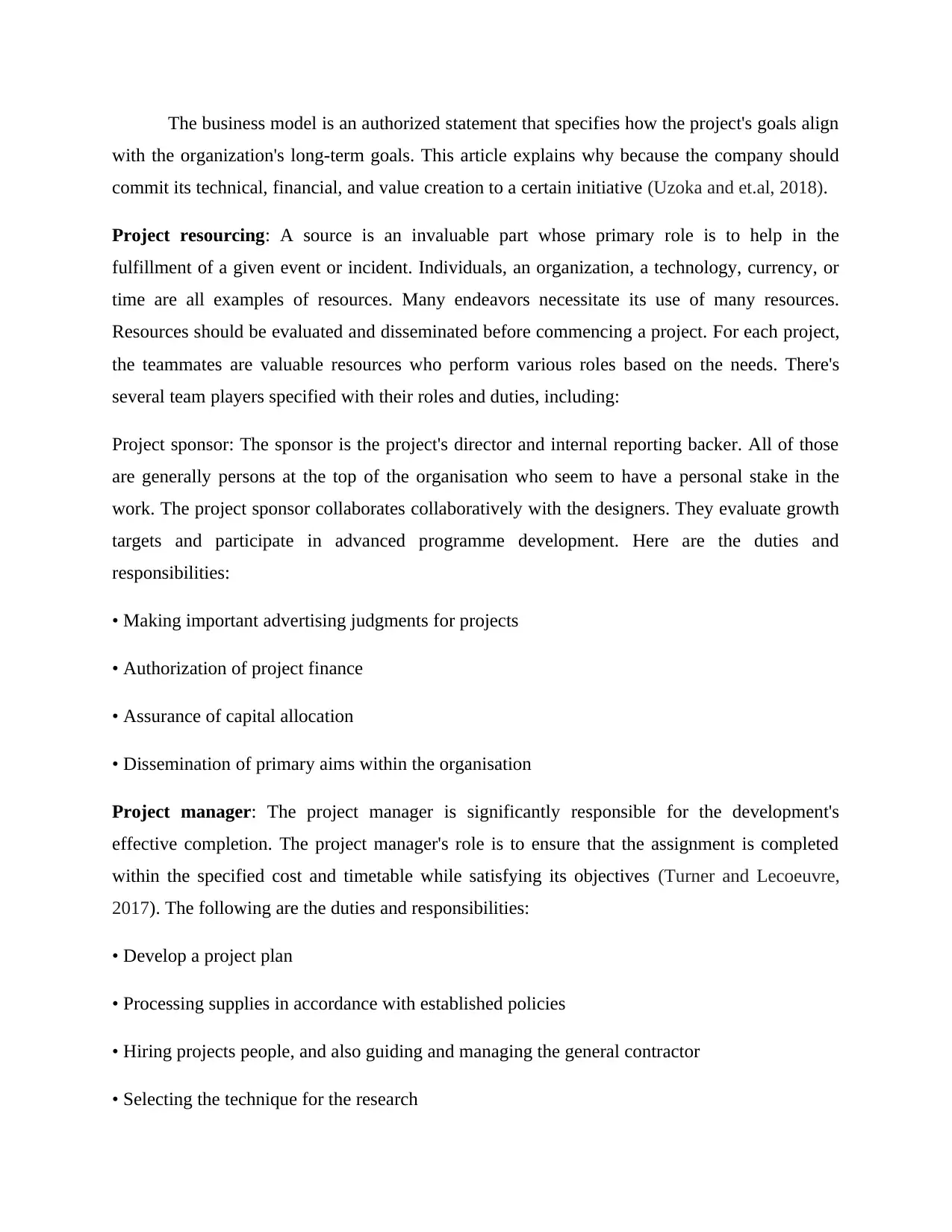
The business model is an authorized statement that specifies how the project's goals align
with the organization's long-term goals. This article explains why because the company should
commit its technical, financial, and value creation to a certain initiative (Uzoka and et.al, 2018).
Project resourcing: A source is an invaluable part whose primary role is to help in the
fulfillment of a given event or incident. Individuals, an organization, a technology, currency, or
time are all examples of resources. Many endeavors necessitate its use of many resources.
Resources should be evaluated and disseminated before commencing a project. For each project,
the teammates are valuable resources who perform various roles based on the needs. There's
several team players specified with their roles and duties, including:
Project sponsor: The sponsor is the project's director and internal reporting backer. All of those
are generally persons at the top of the organisation who seem to have a personal stake in the
work. The project sponsor collaborates collaboratively with the designers. They evaluate growth
targets and participate in advanced programme development. Here are the duties and
responsibilities:
• Making important advertising judgments for projects
• Authorization of project finance
• Assurance of capital allocation
• Dissemination of primary aims within the organisation
Project manager: The project manager is significantly responsible for the development's
effective completion. The project manager's role is to ensure that the assignment is completed
within the specified cost and timetable while satisfying its objectives (Turner and Lecoeuvre,
2017). The following are the duties and responsibilities:
• Develop a project plan
• Processing supplies in accordance with established policies
• Hiring projects people, and also guiding and managing the general contractor
• Selecting the technique for the research
with the organization's long-term goals. This article explains why because the company should
commit its technical, financial, and value creation to a certain initiative (Uzoka and et.al, 2018).
Project resourcing: A source is an invaluable part whose primary role is to help in the
fulfillment of a given event or incident. Individuals, an organization, a technology, currency, or
time are all examples of resources. Many endeavors necessitate its use of many resources.
Resources should be evaluated and disseminated before commencing a project. For each project,
the teammates are valuable resources who perform various roles based on the needs. There's
several team players specified with their roles and duties, including:
Project sponsor: The sponsor is the project's director and internal reporting backer. All of those
are generally persons at the top of the organisation who seem to have a personal stake in the
work. The project sponsor collaborates collaboratively with the designers. They evaluate growth
targets and participate in advanced programme development. Here are the duties and
responsibilities:
• Making important advertising judgments for projects
• Authorization of project finance
• Assurance of capital allocation
• Dissemination of primary aims within the organisation
Project manager: The project manager is significantly responsible for the development's
effective completion. The project manager's role is to ensure that the assignment is completed
within the specified cost and timetable while satisfying its objectives (Turner and Lecoeuvre,
2017). The following are the duties and responsibilities:
• Develop a project plan
• Processing supplies in accordance with established policies
• Hiring projects people, and also guiding and managing the general contractor
• Selecting the technique for the research
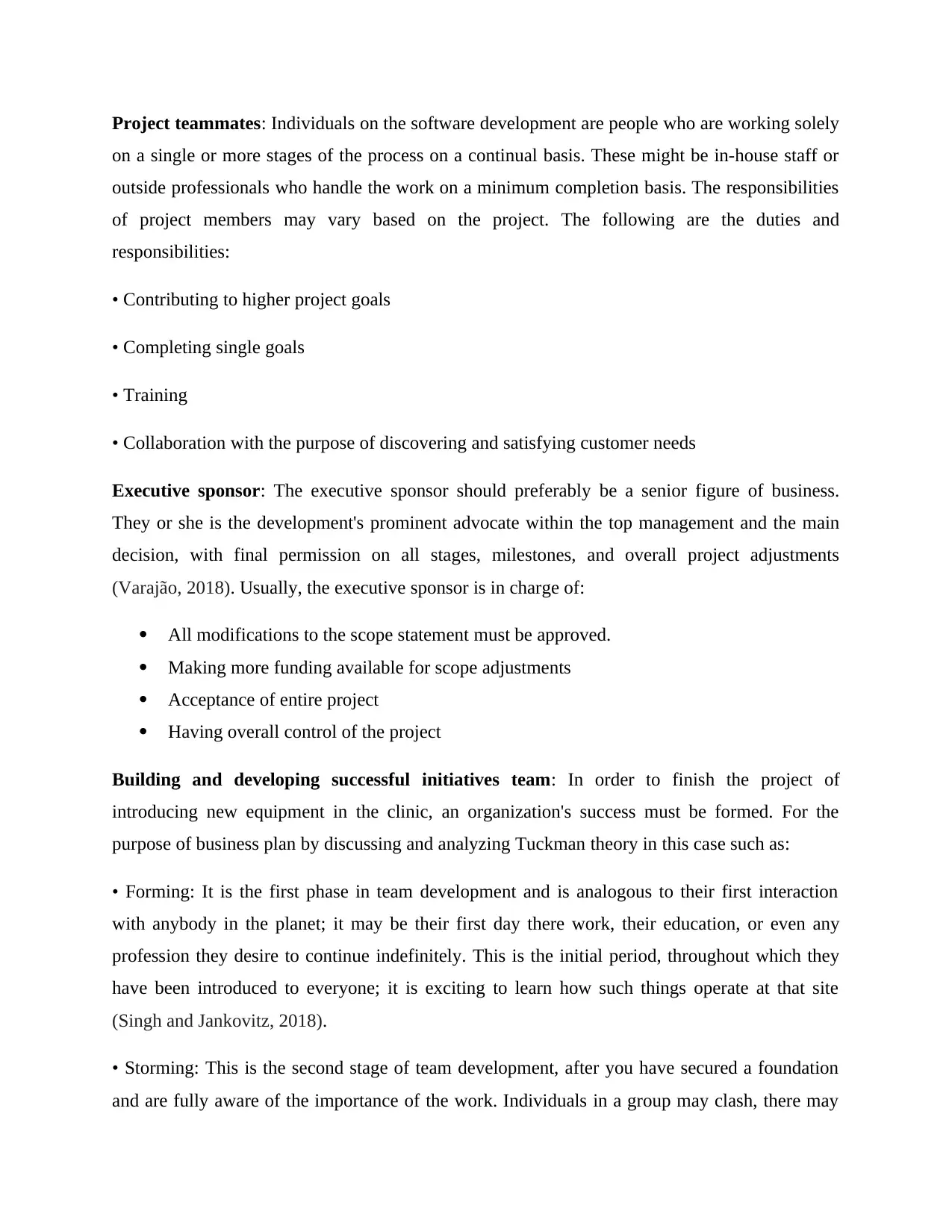
Project teammates: Individuals on the software development are people who are working solely
on a single or more stages of the process on a continual basis. These might be in-house staff or
outside professionals who handle the work on a minimum completion basis. The responsibilities
of project members may vary based on the project. The following are the duties and
responsibilities:
• Contributing to higher project goals
• Completing single goals
• Training
• Collaboration with the purpose of discovering and satisfying customer needs
Executive sponsor: The executive sponsor should preferably be a senior figure of business.
They or she is the development's prominent advocate within the top management and the main
decision, with final permission on all stages, milestones, and overall project adjustments
(Varajão, 2018). Usually, the executive sponsor is in charge of:
All modifications to the scope statement must be approved.
Making more funding available for scope adjustments
Acceptance of entire project
Having overall control of the project
Building and developing successful initiatives team: In order to finish the project of
introducing new equipment in the clinic, an organization's success must be formed. For the
purpose of business plan by discussing and analyzing Tuckman theory in this case such as:
• Forming: It is the first phase in team development and is analogous to their first interaction
with anybody in the planet; it may be their first day there work, their education, or even any
profession they desire to continue indefinitely. This is the initial period, throughout which they
have been introduced to everyone; it is exciting to learn how such things operate at that site
(Singh and Jankovitz, 2018).
• Storming: This is the second stage of team development, after you have secured a foundation
and are fully aware of the importance of the work. Individuals in a group may clash, there may
on a single or more stages of the process on a continual basis. These might be in-house staff or
outside professionals who handle the work on a minimum completion basis. The responsibilities
of project members may vary based on the project. The following are the duties and
responsibilities:
• Contributing to higher project goals
• Completing single goals
• Training
• Collaboration with the purpose of discovering and satisfying customer needs
Executive sponsor: The executive sponsor should preferably be a senior figure of business.
They or she is the development's prominent advocate within the top management and the main
decision, with final permission on all stages, milestones, and overall project adjustments
(Varajão, 2018). Usually, the executive sponsor is in charge of:
All modifications to the scope statement must be approved.
Making more funding available for scope adjustments
Acceptance of entire project
Having overall control of the project
Building and developing successful initiatives team: In order to finish the project of
introducing new equipment in the clinic, an organization's success must be formed. For the
purpose of business plan by discussing and analyzing Tuckman theory in this case such as:
• Forming: It is the first phase in team development and is analogous to their first interaction
with anybody in the planet; it may be their first day there work, their education, or even any
profession they desire to continue indefinitely. This is the initial period, throughout which they
have been introduced to everyone; it is exciting to learn how such things operate at that site
(Singh and Jankovitz, 2018).
• Storming: This is the second stage of team development, after you have secured a foundation
and are fully aware of the importance of the work. Individuals in a group may clash, there may

well be disagreements on how to carry out a task, and questions about senior company's
competency may be raised. Furthermore, disagreements are unavoidable in every organization,
and personal characteristics are common. Every phase is followed by either a lack of consensus
in group discussions, an increase in collective subjective openness, but the potential of
ambiguity.
• Norming: Team consensus determines the third stage. When team takes significant decisions,
the team may engage in a variety of tasks, and there is unity and regard between all colleagues
for each other as well as leadership who promotes the squad.
• Performing: During this stage, colleagues are comfortable and motivated, enthusiastic in
engaging on their jobs with their firm, and capable of operating autonomously. The fourth phase
is something many businesses strive after; there is an united aim, a focus on accomplishing
objectives, and disagreements inside the team are resolved constructively and respectfully. Team
members look out for each other, and the management just offers assistance.
• Closing: Tuckman added a fifth stage to the model after refining the model of team design
phase. Adjournment is vital to the participants, but this has nothing to do with the primary goal
of directing and creating a workforce. It is the split of the organization once the task has been
completed efficiently (Saleem, 2019).
competency may be raised. Furthermore, disagreements are unavoidable in every organization,
and personal characteristics are common. Every phase is followed by either a lack of consensus
in group discussions, an increase in collective subjective openness, but the potential of
ambiguity.
• Norming: Team consensus determines the third stage. When team takes significant decisions,
the team may engage in a variety of tasks, and there is unity and regard between all colleagues
for each other as well as leadership who promotes the squad.
• Performing: During this stage, colleagues are comfortable and motivated, enthusiastic in
engaging on their jobs with their firm, and capable of operating autonomously. The fourth phase
is something many businesses strive after; there is an united aim, a focus on accomplishing
objectives, and disagreements inside the team are resolved constructively and respectfully. Team
members look out for each other, and the management just offers assistance.
• Closing: Tuckman added a fifth stage to the model after refining the model of team design
phase. Adjournment is vital to the participants, but this has nothing to do with the primary goal
of directing and creating a workforce. It is the split of the organization once the task has been
completed efficiently (Saleem, 2019).
Secure Best Marks with AI Grader
Need help grading? Try our AI Grader for instant feedback on your assignments.
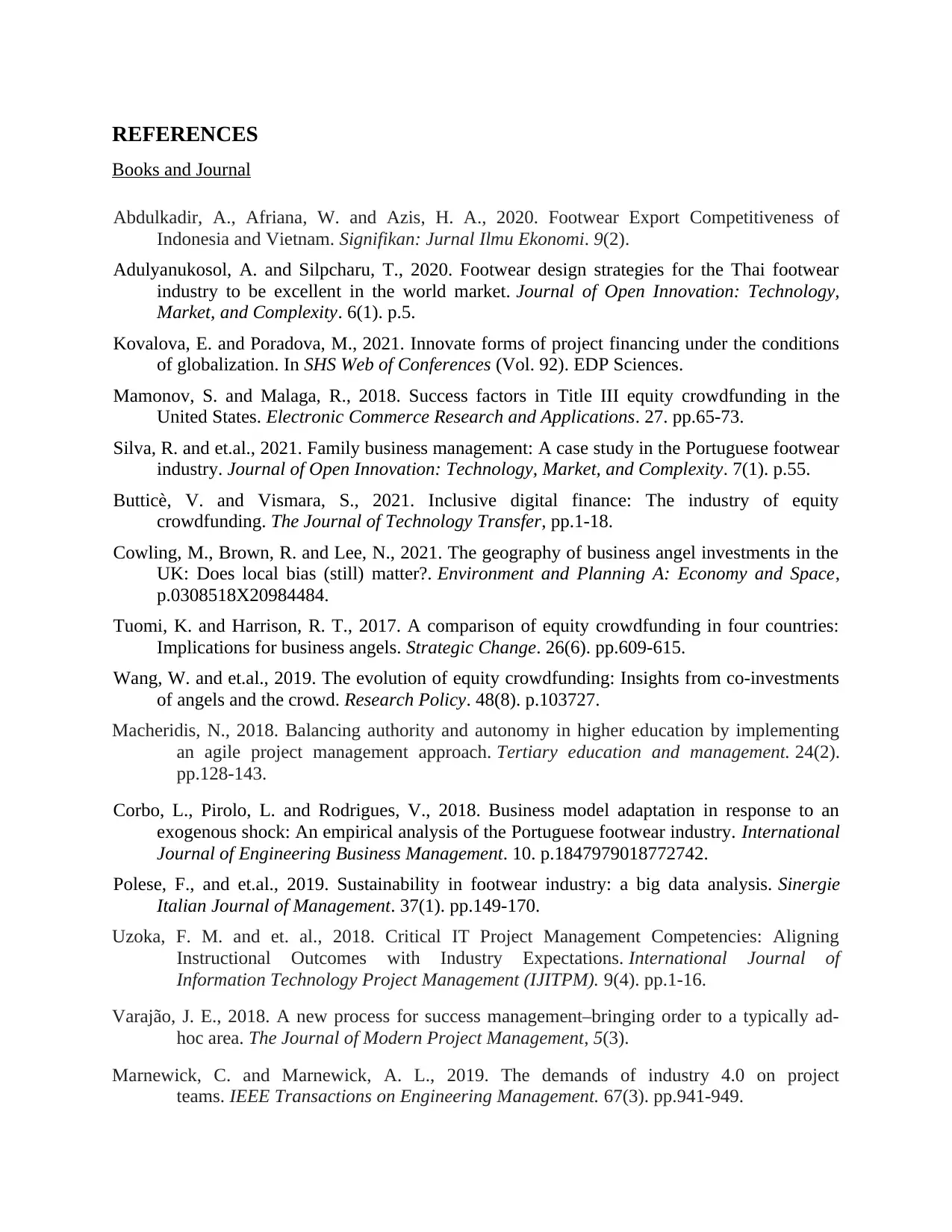
REFERENCES
Books and Journal
Abdulkadir, A., Afriana, W. and Azis, H. A., 2020. Footwear Export Competitiveness of
Indonesia and Vietnam. Signifikan: Jurnal Ilmu Ekonomi. 9(2).
Adulyanukosol, A. and Silpcharu, T., 2020. Footwear design strategies for the Thai footwear
industry to be excellent in the world market. Journal of Open Innovation: Technology,
Market, and Complexity. 6(1). p.5.
Kovalova, E. and Poradova, M., 2021. Innovate forms of project financing under the conditions
of globalization. In SHS Web of Conferences (Vol. 92). EDP Sciences.
Mamonov, S. and Malaga, R., 2018. Success factors in Title III equity crowdfunding in the
United States. Electronic Commerce Research and Applications. 27. pp.65-73.
Silva, R. and et.al., 2021. Family business management: A case study in the Portuguese footwear
industry. Journal of Open Innovation: Technology, Market, and Complexity. 7(1). p.55.
Butticè, V. and Vismara, S., 2021. Inclusive digital finance: The industry of equity
crowdfunding. The Journal of Technology Transfer, pp.1-18.
Cowling, M., Brown, R. and Lee, N., 2021. The geography of business angel investments in the
UK: Does local bias (still) matter?. Environment and Planning A: Economy and Space,
p.0308518X20984484.
Tuomi, K. and Harrison, R. T., 2017. A comparison of equity crowdfunding in four countries:
Implications for business angels. Strategic Change. 26(6). pp.609-615.
Wang, W. and et.al., 2019. The evolution of equity crowdfunding: Insights from co-investments
of angels and the crowd. Research Policy. 48(8). p.103727.
Macheridis, N., 2018. Balancing authority and autonomy in higher education by implementing
an agile project management approach. Tertiary education and management. 24(2).
pp.128-143.
Corbo, L., Pirolo, L. and Rodrigues, V., 2018. Business model adaptation in response to an
exogenous shock: An empirical analysis of the Portuguese footwear industry. International
Journal of Engineering Business Management. 10. p.1847979018772742.
Polese, F., and et.al., 2019. Sustainability in footwear industry: a big data analysis. Sinergie
Italian Journal of Management. 37(1). pp.149-170.
Uzoka, F. M. and et. al., 2018. Critical IT Project Management Competencies: Aligning
Instructional Outcomes with Industry Expectations. International Journal of
Information Technology Project Management (IJITPM). 9(4). pp.1-16.
Varajão, J. E., 2018. A new process for success management–bringing order to a typically ad-
hoc area. The Journal of Modern Project Management, 5(3).
Marnewick, C. and Marnewick, A. L., 2019. The demands of industry 4.0 on project
teams. IEEE Transactions on Engineering Management. 67(3). pp.941-949.
Books and Journal
Abdulkadir, A., Afriana, W. and Azis, H. A., 2020. Footwear Export Competitiveness of
Indonesia and Vietnam. Signifikan: Jurnal Ilmu Ekonomi. 9(2).
Adulyanukosol, A. and Silpcharu, T., 2020. Footwear design strategies for the Thai footwear
industry to be excellent in the world market. Journal of Open Innovation: Technology,
Market, and Complexity. 6(1). p.5.
Kovalova, E. and Poradova, M., 2021. Innovate forms of project financing under the conditions
of globalization. In SHS Web of Conferences (Vol. 92). EDP Sciences.
Mamonov, S. and Malaga, R., 2018. Success factors in Title III equity crowdfunding in the
United States. Electronic Commerce Research and Applications. 27. pp.65-73.
Silva, R. and et.al., 2021. Family business management: A case study in the Portuguese footwear
industry. Journal of Open Innovation: Technology, Market, and Complexity. 7(1). p.55.
Butticè, V. and Vismara, S., 2021. Inclusive digital finance: The industry of equity
crowdfunding. The Journal of Technology Transfer, pp.1-18.
Cowling, M., Brown, R. and Lee, N., 2021. The geography of business angel investments in the
UK: Does local bias (still) matter?. Environment and Planning A: Economy and Space,
p.0308518X20984484.
Tuomi, K. and Harrison, R. T., 2017. A comparison of equity crowdfunding in four countries:
Implications for business angels. Strategic Change. 26(6). pp.609-615.
Wang, W. and et.al., 2019. The evolution of equity crowdfunding: Insights from co-investments
of angels and the crowd. Research Policy. 48(8). p.103727.
Macheridis, N., 2018. Balancing authority and autonomy in higher education by implementing
an agile project management approach. Tertiary education and management. 24(2).
pp.128-143.
Corbo, L., Pirolo, L. and Rodrigues, V., 2018. Business model adaptation in response to an
exogenous shock: An empirical analysis of the Portuguese footwear industry. International
Journal of Engineering Business Management. 10. p.1847979018772742.
Polese, F., and et.al., 2019. Sustainability in footwear industry: a big data analysis. Sinergie
Italian Journal of Management. 37(1). pp.149-170.
Uzoka, F. M. and et. al., 2018. Critical IT Project Management Competencies: Aligning
Instructional Outcomes with Industry Expectations. International Journal of
Information Technology Project Management (IJITPM). 9(4). pp.1-16.
Varajão, J. E., 2018. A new process for success management–bringing order to a typically ad-
hoc area. The Journal of Modern Project Management, 5(3).
Marnewick, C. and Marnewick, A. L., 2019. The demands of industry 4.0 on project
teams. IEEE Transactions on Engineering Management. 67(3). pp.941-949.
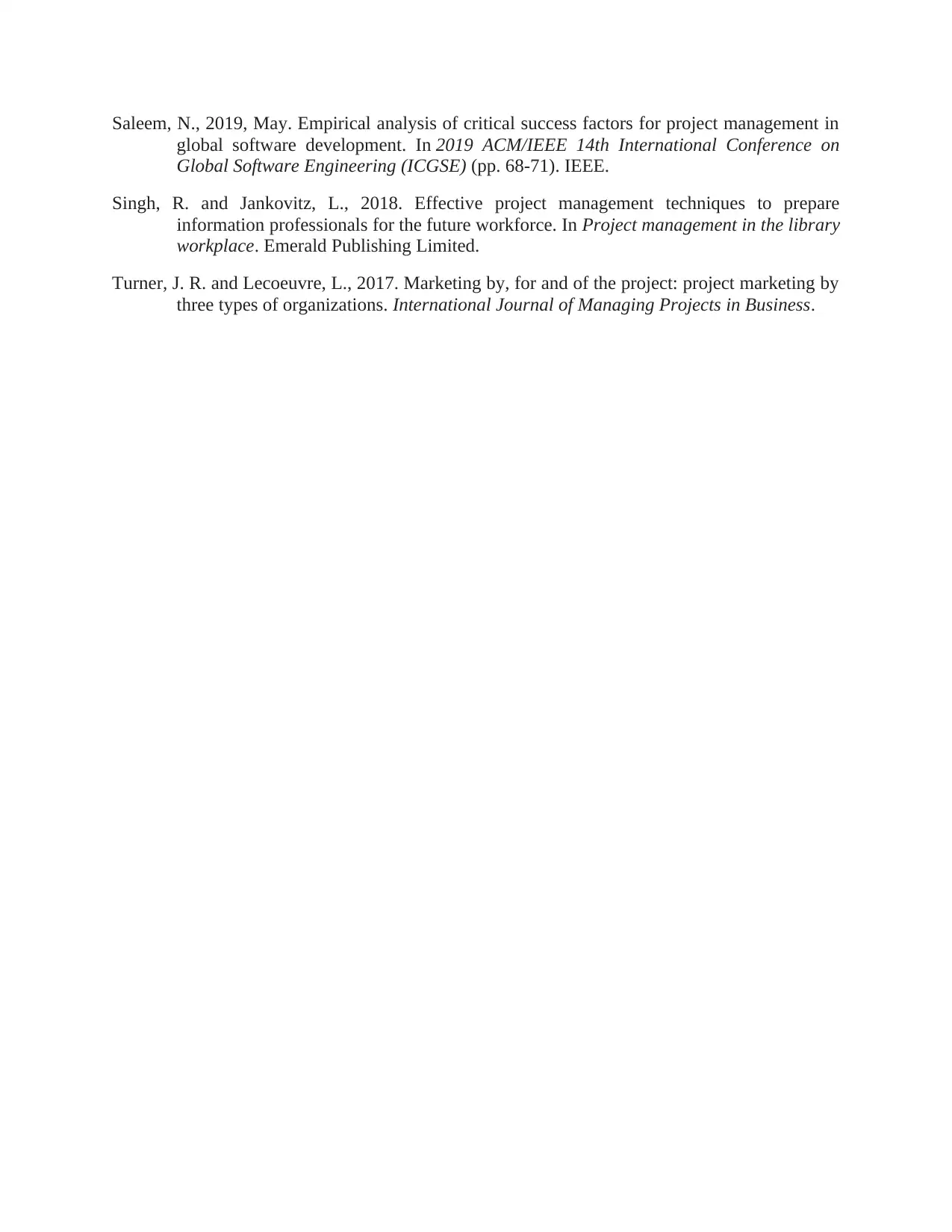
Saleem, N., 2019, May. Empirical analysis of critical success factors for project management in
global software development. In 2019 ACM/IEEE 14th International Conference on
Global Software Engineering (ICGSE) (pp. 68-71). IEEE.
Singh, R. and Jankovitz, L., 2018. Effective project management techniques to prepare
information professionals for the future workforce. In Project management in the library
workplace. Emerald Publishing Limited.
Turner, J. R. and Lecoeuvre, L., 2017. Marketing by, for and of the project: project marketing by
three types of organizations. International Journal of Managing Projects in Business.
global software development. In 2019 ACM/IEEE 14th International Conference on
Global Software Engineering (ICGSE) (pp. 68-71). IEEE.
Singh, R. and Jankovitz, L., 2018. Effective project management techniques to prepare
information professionals for the future workforce. In Project management in the library
workplace. Emerald Publishing Limited.
Turner, J. R. and Lecoeuvre, L., 2017. Marketing by, for and of the project: project marketing by
three types of organizations. International Journal of Managing Projects in Business.
1 out of 18
Related Documents
Your All-in-One AI-Powered Toolkit for Academic Success.
+13062052269
info@desklib.com
Available 24*7 on WhatsApp / Email
![[object Object]](/_next/static/media/star-bottom.7253800d.svg)
Unlock your academic potential
© 2024 | Zucol Services PVT LTD | All rights reserved.




